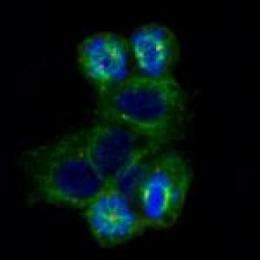Scientists discover inner workings of potent cancer drug

A potent drug derived from an evergreen tree may soon save the lives of some patients with the deadliest form of breast cancer. According to the National Cancer Institute, breast cancer will claim approximately 40,000 lives in the U.S. this year.
Scientists at UC Santa Barbara, in cooperation with scientists in the pharmaceutical industry, have discovered the mechanism by which this drug kills cancer cells. The team has isolated the drug's action in the test tube as well as in cancer cells.
The results are reported in two studies published as the cover story of the October issue of Molecular Cancer Therapeutics, authored by a team of UCSB researchers. The articles feature work performed in the laboratories of Mary Ann Jordan and Leslie Wilson, professors in UCSB's Department of Cellular, Molecular and Developmental Biology.
"This anticancer drug, called maytansine, when linked to a tumor-targeting antibody, shows promising early results in clinical trials on patients with metastatic breast cancer," said Jordan. "Although the drug is not yet approved by the FDA, current clinical trials are open to new patients. And, the drug is being tested, with good results, on other cancers, such as multiple myeloma and B-cell lymphoma."
Early clinical trials show that the drug shrank the tumors of one-third of the patients in the breast cancer study –– a strong result, according to the authors. The studies explain that the drug works by targeting the microtubules of cancer cells. Microtubules are the dynamic, rapidly growing and shortening protein filaments that help cells to divide and multiply.
"We discovered how the drug is taken up into the tumor cells," said Jordan. "We found out that it is metabolized by the cancer cells, inhibits the dynamics of cellular microtubules, and thus blocks the mitosis of the spindles in the cells, causing them to die."
Manu Lopus, a postdoctoral fellow at UCSB and first author of the first article, demonstrated that the maytansinoid molecules act directly on the microtubules and their component tubulin. Emin Oroudjev, first author of the second article, demonstrated the course of action of the maytansinoids after they enter the cancer cells. "When microtubules lose their natural ability to grow and shorten, they can no longer execute their key functions that are crucial to successful mitosis, thus preventing the cancer cells from dividing, and prohibiting cancer cell proliferation," said Lopus.
The drug was previously considered too dangerous to use, because of its toxicity to non-cancer cells. However, the team was able to show that modifying the anticancer drug by adding an antibody caused the drug to target only cancer cells, greatly reducing its toxicity.
The new drug, when linked with the breast cancer-targeting antibody, is named trastuzumab-DM1. DM1 is a synthetic derivative of maytansine, a molecule found in an evergreen tree in the genera Maytenus, which grows on several continents.














